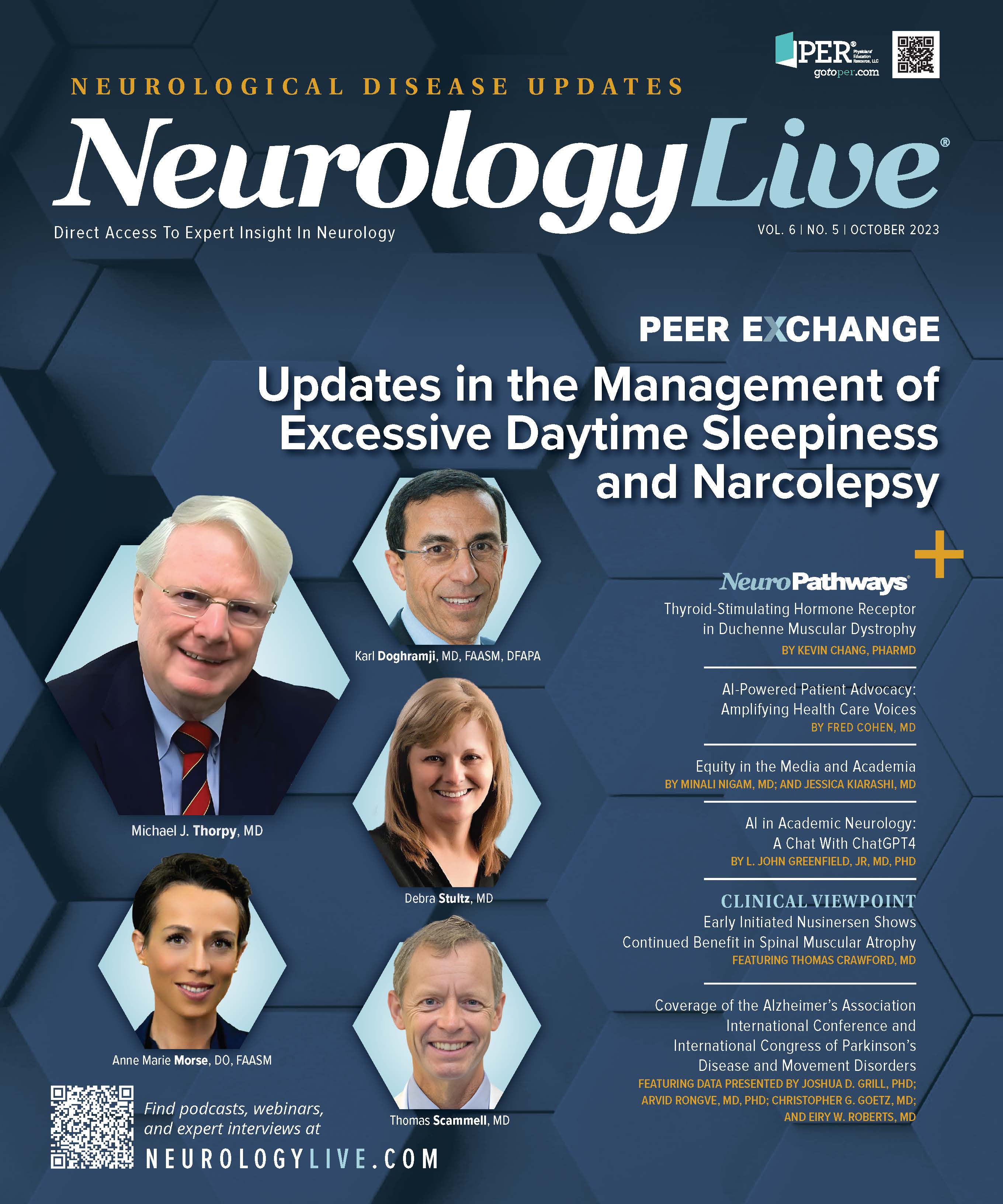Feature
Article
NeurologyLive
Thyroid-Stimulating Hormone Receptor in Duchenne Muscular Dystrophy
Author(s):
Recent research has suggested a role for thyroid hormones and their receptor, thyrotropin, in muscle regeneration and development, making a case for further investigation in DMD.

Kevin Chang, PharmD

DUCHENNE MUSCULAR DYSTROPHY (DMD) is a severe genetic condition characterized by progressive muscle degeneration and weakness due to the absence of the dystrophin protein.1 The absence of dystrophin leads to increased susceptibility to mechanical stress, muscle degeneration, and impaired muscle regeneration.2 DMD is one of the most common and severe forms of muscular dystrophy, with an estimated prevalence of 1 in 5000 male births worldwide with most patients dying by age 30 years because of cardiorespiratory failure.1,3 According to the American Academy of Neurology, the current mainstay of treatment is symptomatic management with prednisone.4 Currently there are new therapies being explored for DMD through exon-skipping and gene-editing therapies1; however, exon-skipping therapies are limited by low efficacy and high toxicity and gene-editing therapies are limited by inflammatory immune responses.1 Despite these challenges, recent research has highlighted the potential role of thyroid hormones and their receptor, the thyroid-stimulating hormone receptor (thyrotropin), in muscle regeneration and development, offering promising avenues for further investigation and potential therapeutic strategies in DMD.
Thyrotropin is a G protein–coupled receptor in the glycoprotein hormone receptor family.5,6 Its primary function is to regulate the synthesis and secretion of thyroid hormones (THs), triiodothyronine (T3), and thyroxine (T4), which play critical roles in numerous physiological processes.6 In skeletal muscle, TH is necessary for muscle development, contractile function, metabolism, and myogenesis.2,7 Managing the balance of T3 and T4 is important in muscle regeneration and disturbances to this balance manifest as myopathies seen in hyperthyroid and hypothyroid conditions.2,3,8
Control of intracellular T3 is important in myogenesis progression and is facilitated by Thyrotropin signaling and gene expression regulation through thyroid hormone transporters and deiodinases, specifically type 2 (D2) and type 3 (D3)7,8 (FIGURE9). As the correct progression of myogenesis is handled by myogenic regulatory factors, sequential expression of D3 and D2 are more important than plasmatic T3 concentrations and provide a mechanism for prereceptor regulation of intracellular TH independent of plasma T3 concentrations.2 D2 activates T4 to T3 and promotes stem cell (SC) differentiation while D3 is the primary inactivator of T3, helps promote SC proliferation, and prevents TH from triggering apoptosis.2,7 Regulating intracellular T3 is important because intracellular T3 directly induces myoblast determination protein 1 (MYOD1), a master transcriptional regulator of myogenesis.7,8 Ambrosio et al hypothesize that a fine-tuned control of intracellular T3 through deiodinases may be beneficial in DMD for when SC proliferation or differentiation is desired7 and that selective deiodinase modulators may avoid systemic TH changes and adverse effects.2

Recent scientific investigations have shed light on the role of TH in myogenesis and its potential implications for DMD. Research by Taglietti et al has highlighted intriguing insights into the regenerative capacity of muscles and the impact of Thyrotropin signaling on muscle stem cell senescence.10 This study revealed that extraocular muscles (EOMs) remain regenerative in a DMD rat model (R-DMDdel52), offering a unique site for understanding muscle regeneration.10 In R-DMDdel52, senescence markers P21, P16, and γH2AX were found to be elevated in limb muscles but absent in EOMs.10 As early as 3 weeks, and over time, most limb SCs exhibited a senescent phenotype in R-DMDdel52 compared with wild-type (WT) counterparts.10 The early senescence of SCs was identified as a central mechanism driving progressive loss of muscle regenerative potential in DMD.10 EOMs, on the other hand, exhibited a stable regenerative capacity over time in R-DMDdel52 compared with limb SCs.10 Pax7 (a marker for SCs) and Ki67 (a marker for proliferation) staining showed no difference in number of SCs per fiber between R-DMDdel52 and WT rats.10 EOM SCs remained Ki67 positive throughout the first year in R-DMDdel52, indicating their continuous regenerative potential based on a stable pool of self-renewing SCs.10
Thyrotropin prevalence in EOMs was also more abundant compared with limb muscles in R-DMDdel52.10 The use of ML224, a thyrotropin inverse agonist, compromised myoblast proliferation and increased senescence signature expression in EOMs.10 This phenomenon was also confirmed in human EOM myoblasts treated with ML224 but not in limb muscles.10 The role of thyrotropin signaling was further emphasized, as forskolin, a potent adenylyl cyclase activator, was shown to prevent entry into senescence and maintained the myogenic potential of EOM SCs even after treatment with ML224.10 Forskolin-treated limb SCs of R-DMDdel52 also exhibited increased proliferation, limited senescence gene overexpression, and improved differentiation potential compared with control R-DMDdel52 treated with vehicle.10 Forskolin treatment also resulted in enhanced myofiber regeneration and proliferation, while decreasing SCs with P16 in limb muscles.10 Taglietti et al suggest that activation of the thyrotropin pathway by forskolin opens the possibility of exploring other thyrotropin mechanisms that may improve muscle regeneration in DMD.10
The intricate mechanisms of thyrotropin signaling, T3 regulation via deiodinases, and its impacts on SC senescence, proliferation, and differentiation hold promise for therapeutic interventions. As ongoing research delves deeper into these mechanisms, the potential for targeted interventions and improved outcomes for individuals with DMD becomes increasingly tangible.
For correspondence:
Kevin Chang, PharmD
kevinchang1@gmail.com
REFERENCES
1. Sun C, Shen L, Zhang Z, Xie X. Therapeutic strategies for Duchenne muscular dystrophy: an update. Genes (Basel). 2020;11(8):837. doi:10.3390/genes11080837
2.De Stefano MA, Ambrosio R, Porcelli T, Orlandino G, Salvatore D, Luongo C. Thyroid hormone action in muscle atrophy. Metabolites. 2021;11(11):730. doi:10.3390/metabo11110730
3.Bloise FF, Oliveira TS, Cordeiro A, Ortiga-Carvalho TM. Thyroid hormones play role in sarcopenia and myopathies. Front Physiol. 2018;9:560. doi:10.3389/fphys.2018.00560
4. Gloss D, Moxley RT 3rd, Ashwal S, Oskoui M. Practice guideline update summary: corticosteroid treatment of Duchenne muscular dystrophy: report of the Guideline Development Subcommittee of the American Academy of Neurology. Neurology. 2016;86(5):465-472. doi:10.1212/WNL.0000000000002337
5. Davies TF, Latif R. Targeting the thyroid-stimulating hormone receptor with small molecule ligands and antibodies. Expert Opin Ther Targets. 2015;19(6):835-847. doi:10.1517/14728222.2015.1018181
6. Tedeschi L, Vassalle C, Iervasi G, Sabatino L. Main factors involved in thyroid hormone Action. Molecules. 2021;26(23):7337. doi:10.3390/molecules26237337
7. Ambrosio R, De Stefano MA, Di Girolamo D, Salvatore D. Thyroid hormone signaling and deiodinase actions in muscle stem/progenitor cells. Mol Cell Endocrinol. 2017;459:79-83. doi:10.1016/j.mce.2017.06.014
8. Salvatore D, Simonides WS, Dentice M, Zavacki AM, Larsen PR. Thyroid hormones and skeletal muscle--new insights and potential implications. Nat Rev Endocrinol. 2014;10(4):206-214. doi:10.1038/nrendo.2013.238
9. Bloise FF, Cordeiro A, Ortiga-Carvalho TM. Role of thyroid hormone in skeletal muscle physiology. J Endocrinol. 2018;236(1):R57-R68. doi:10.1530/JOE-16-0611
10. Taglietti V, Kefi K, Rivera L, et al. Thyroid-stimulating hormone receptor signaling restores skeletal muscle stem cell regeneration in rats with muscular dystrophy. Sci Transl Med. 2023;15(685):eadd5275. doi:10.1126/scitranslmed.add5275





